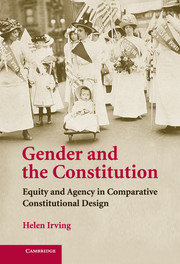10 - Conclusions: Amendment and Compliance
Published online by Cambridge University Press: 08 December 2009
Summary
Constitutional design can never be settled with finality. A constitution will always be liable to alteration, either expressly or through shifts in interpretation that arise through changes in methodological “fashion” or in response to social and technological developments. Gender auditing will need to continue, even if the goals of equity and agency have closely guided the original process of framing. Constitutional interpretation, tailored to the purpose of promoting and protecting gender equity, will involve a continuous commitment to bringing together purpose and current context. This will require continuous argument and advocacy, exploration of new ways in which the original purpose may find expression, and recognition of new forms of injury or harm for which constitutional remedies, attached to this purpose, may be applied. No matter how well designed, a constitution can never be a “machine that goes of itself”; it will always require rewinding, lubricating, and repairing. It will always need both enforcement and amendment.
Enforcement cannot lie purely in the judicial process. For reasons argued throughout this book, to depend on individual litigation as the primary method of enforcing governmental compliance with constitutional provisions is both unsatisfactory and sometimes inequitable. It privatizes the enforcement of public welfare. It places the burden of doing so on the disadvantaged party, and reinforces the very asymmetry in power that gave rise to the disadvantage or injury.
- Type
- Chapter
- Information
- Gender and the ConstitutionEquity and Agency in Comparative Constitutional Design, pp. 251 - 259Publisher: Cambridge University PressPrint publication year: 2008



